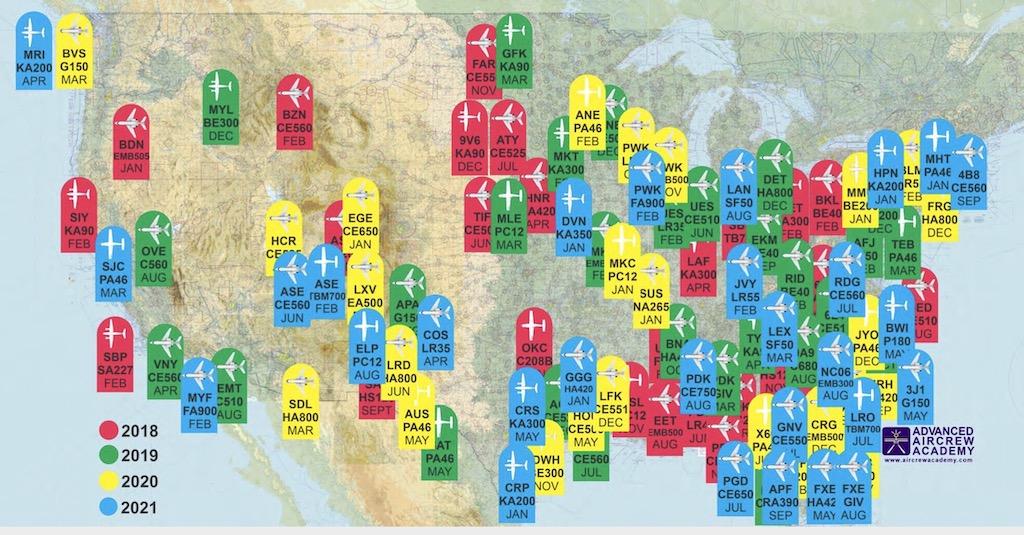
There have been about 100 runway excursions by business aviation aircraft in the U.S. over the last three and a half years, says training company Advanced Aircrew Academy, which has cataloged each incident in a quest to identify the causal factors.
The top three airports for business aviation runway excursions over the last five years have been DeKalb-Peachtree Airport (PDK) in Georgia, with six; Chicago Executive Airport (PWK), in Illinois, with five; and Aspen Airport (ASE), in Colorado, with three, reports Advanced Aircrew Academy CEO Dan Boedigheimer.
During a workshop he led Nov. 2 at the Bombardier Safety Standdown in Wichita, Boedigheimer reviewed findings and recommendations of the Global Action Plan for the Prevention of Runway Excursions (GAPPRE), a report released in January by project coordinators Eurocontrol and Flight Safety Foundation.
Causal Factors

Accident data compiled by the International Air Transport Association, a participant in the GAPPRE initiative, revealed that 23% of aviation accidents between 2005 and the first half of 2019 involved a runway excursion—when an aircraft veers off or overruns the runway during takeoff or landing. Research by the Netherlands Aerospace Center, another project participant, identified wet or contaminated runways, long landings, fast approaches, crosswind and system failure among top causal factors in runway excursions.
The GAPPRE report contains 100 recommendations for airport operators, air navigation service providers, aircraft operators, manufacturers and regulators. Boedigheimer emphasized the 35 recommendations devoted to aircraft operators and further categorized incidents as resulting from non-compliance with procedures, unstabilized approaches, wet or contaminated runways and wind.
Runway excursions could be prevented if pilots stay aware of conditions at the airport, keep to established procedures and execute go-arounds when an aircraft falls short of stabilized approach criteria, Boedigheimer said.
One feature that PDK and PWK share, he observed, is that both airports have installed engineered materials arresting systems (EMAS)—arrestor beds of crushable material—to stop an aircraft that overruns the runway. PDK installed EMAS on its 6,001-ft. main Runway 3R/21L in 2018-19.
PWK installed an EMAS at each end of 5001-ft. Runway 16/34 in 2014-15. In January 2016, the engineered surface prevented a Kalitta Charters’ Dassault Falcon 20 from overrunning Runway 16 at the south end of the airport, which is bordered by a highway.
“What do these two airports have in common—they’ve got EMAS,” Boedigheimer said. “So, EMAS would be a red flag for me to say there’s a reason why they spent the money to put EMAS in on this particular runway at this particular airport because it has some higher, elevated risk factors associated with it. If a runway I’m landing on has EMAS, that’s a new briefing item for me.”
Pilots should be conservative, he said, when evaluating conditions at the airport, such as a wet runway or a contaminated runway that is partially covered by standing water, snow, slush or ice.
“In half of the runway excursions that happened on wet or contaminated runways, what the crew thought the runway was did not match actual conditions,” Boedigheimer said. “Even though an airport is required to file a field-condition Notam (Notice to Airmen) any time the runway is not considered dry, in reality, especially at uncontrolled fields and smaller airports, we’re not seeing that come to fruition.”
Boedigheimer continued: “How as a pilot can you get an accurate assessment of runway conditions if it’s not being handed to you by ATC or delivered via the Notam system? [By] conservative decision making, conservative risk management—if moisture is present, if it has snowed, assume the worst-case scenario unless you can get positive feedback that it’s better than you anticipate.”





